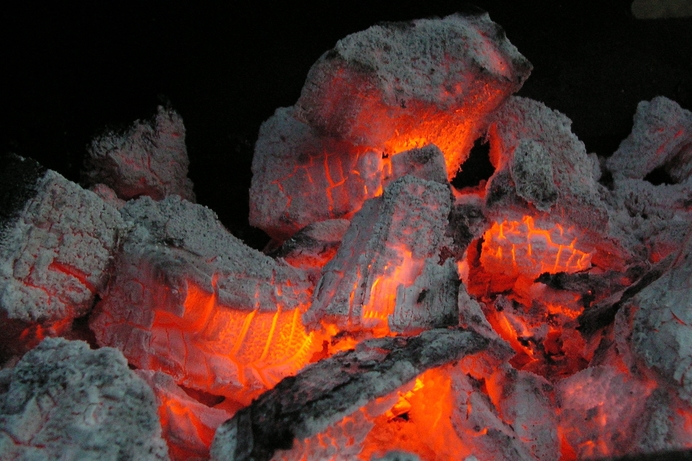
The Catholic Faith that once made Europe great still burns.
From Ember to Fire: Catholicism Discreetly reemerges in Europe
“The smoking flax he shall not extinguish,” says the Gospel about Our Lord.1 Although the once-Catholic European countries are largely covered in the ashes of apostasy, immorality and indifference, a tiny spark of Faith still smolders. This ember is showing its increasing light and warmth in Europe. The most emblematic case is France.
Penance on Social Media
Last Lent, French social media was filled with references to fasting and other penitential practices. On Ash Wednesday, parish priests were surprised by large numbers of young people waiting to have their foreheads marked not by the ash of indifference but that of penance. The media registered the fact with astonishment:
“These impressive scenes are no exception. From Nantes to Nice, from Paris to Bordeaux, parishes were flooded with an unprecedented number of people attending Ash Wednesday Mass, marking the beginning of Lent. A notable feature of the crowds was the massive presence of young people—many of which were not even catechumens and others who had strayed far from the Church. Against all expectations, they all came through the doors of the churches.”2
Read also: Call for a Crusade Against the Massacre of the Innocents in the 21st century
#Carême2025
On TikTok, the hashtag “Carême2025” (Lent 2025) registered unprecedented success. With the grey ashen cross still on their foreheads, the young faithful recorded videos encouraging followers to engage in Lenten exercises, including fasting and abstinence. Several clips got tens of thousands of likes, while questions about the Faith and requests for spiritual advice flooded the comments section. Priest and journalist Fr. Danziec (his pen name) succinctly observed: “There is a real search for the sacred because people need points of reference. The ashes are a marker of this need in the literal sense.”3
Dire Religious Picture
One could rightly ponder the significance of these social media phenomena since these trends are generally ephemeral. The European religious picture, particularly in France, remains dire. While eleven percent of French people attend seasonal Masses on feasts like Christmas, only two percent of the population observe the Sunday precept every week. At the end of the fifties, more than 90% of children were baptized within three months of birth. The rate is now below twenty percent. According to the 2018 European Values Study survey, “declared Church membership has fallen from 70% to 32% of the population over the last forty years.”4
These figures notwithstanding, a discreet but growing flow of converts, especially young people, shows that “realizing that it has become a minority, Catholicism is regaining its intensity,” says Yann du Cleuziou, a professor of political science at the University of Bordeaux. 5
The Catholic majority of the fifties was actually in the throes of a steep decline in fervor. This deterioration culminated in the conciliar crisis and the Sorbonne revolution in May 1968. Most church attendance at that time was maintained merely by the force of inertia or social habits.
On the contrary, the current surge of religious fervor is fueled by the special zeal and impetus of converts.
Do you always want to be updated with the latest news on the defence of Christian civilisation and moral values?
Sign up for the newsletter!
Turning off the Cell Phones for Prayer
Father Benoît Pouzin, from the diocese of Valence, points out that “ten or fifteen years ago, it was difficult to get young people to pray. Today, they are very keen to do so. When we go on retreats, what impresses them most is the time of prayer and silence, when we turn off all our cell phones. Religion offers things that appeal to them, such as meditation, inner well-being…”6
Indeed, in France and other European countries, the new conversions start with a thirst to fill the inner void created by modern life. Then follows the attraction for traditional practices of penance, such as fasting and pilgrimages, seen as palpable means for purifying themselves of sins and reconciling with God. What a conundrum this presents for those without faith! How to explain these youth seeking suffering…to obtain the joy that hedonism doesn’t give!
A recent example of this thirst for meaning was the Pentecost pilgrimage from Paris to Chartres. Meant to promote the Traditional Latin Mass, it attracted a record number of young people last year who made the sacrifice of walking over sixty miles over three days.7 The organizers had to close the registrations at 18,000, with thousands more waiting in line.
Get involved with Our Studies for Catholic Men
Breath of the Holy Spirit and the Smile of Mary Most Holy
Finally, the newcomers want to receive the sacraments, often in the traditional rite. This Easter, a record of 10,300 adults and 7,400 teenagers were baptized, an increase of 45% over 2024. These figures confirm the trend for growth observed over the last five years.8
Thus, as Holy Mother Church celebrates the Paschal season, there are signs that the smoking flax of Faith, by the breath of the Holy Spirit, and the smile of Mary Most Holy, may pierce the ashes, enkindle the embers and become a vigorous fire, to fulfill the will of Our Lord: “I am come to cast fire on the earth; and what will I, but that it be kindled?”9
Footnotes
- Mt 12:20.
- Famille Chretienne, 3/6/2025.
- Boulevard Voltaire, 3/15/2025.
- Le Figaro, 12/25/2025.
- Idem. The professor is the co-author with Florian Michel, of a book titled À la droite du Père. Les catholiques et les droites de 1945 à nos jours (Éditions du Seuil, 2022).
- Huffington Post (French Edition), 3/9/25.
- La Croix, 5/19/24.
- Famille Chretienne, 4/10/24.
- Luke, 12:49.
